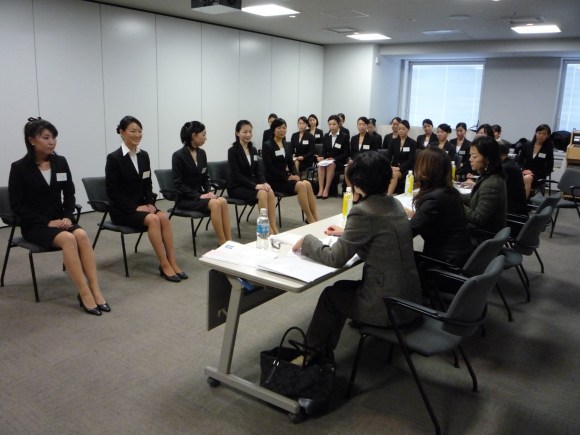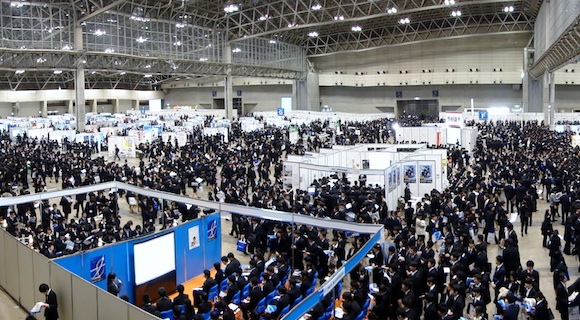
As far as things not to say in an interview go, you’d think it’d be pretty high up on the list. But the young Japanese university student, rejected by all the other companies he’d applied to, was prepared to take the risk. “This company is the only option I have left,” he pleaded with the interviewer. “I’ll do anything!” An unusual strategy, certainly. But he got the job.
Japanese site Niconico News reports that the man is now entering his ninth year of employment with the company, so it seems the gamble paid off. But is the company’s positive reaction so unusual? Some Japanese employability experts are arguing that, for many companies, the ideal graduate recruit is a “hakushi” – a blank page that the company can do what they want with. When companies train new recruits extensively, an across-the-board willingness to learn is valued more than previous experience.
The process of job hunting that the vast majority of Japanese university students take part in is known as “shūkatsu” (from “shūshoku katsudou” 就職活動). Unlike many other countries where students wait until their final year or after graduating to look for work, Japanese students take part in a rigidly-scheduled process which begins in their third year of university with a programme of internships, applications, and interviews. By the beginning or middle of fourth year, most students have already been hired for the job they will take up on April 1 the following year.
▼ A company information session for student job-hunters.
Students are under an enormous amount of pressure to succeed in entering a company. With companies preferring new graduates, those who fail to find work during the set shūkatsu period can find it increasingly difficult to be hired as a “previous graduate”. Finding a job out of university is no longer the guarantee of employment for life it once was, but this pressure to secure a position as soon as you graduate is the desperation that leads some students to feel that any job, any company, any field is fine, so long as it’s a job. Having a specialised area of interest, therefore, can actually be seen as inflexibility.
Yoku Date, a businessman and academic who writes on employability, says that compared to an applicant who talks about their experience and skills up to now in specific terms, one who simply shows a willingness to accept and learn the company’s way of doing things will provide the blank slate which employers are looking for. To succeed in job-hunting, he argues, students must draw a line under their university experience and be accommodating to the challenges of the world of work.
▼ Another unorthodox, and probably less effective, method.
But while some employers welcome the enthusiasm of those with an “I’ll do anything” attitude, others feel that it goes too far. Nobuhiro Kawaharasaki, CEO of web start-up logmi, blogged on June 15 that these kind of utterances show a lack of substance:
“When an applicant says ‘I’ll do anything!’ or ‘I’d give anything!’, just entering the company has become their only goal.”
Instead, he looks for a candidate who can work to take the company in new directions after they are hired. Their focus, he argues, should be one what they will do after they join the company, not only on the objective of finding a job. This approach is particularly relevent for startups, whose success will depend on innovation and intelligent risk-taking.
Of Japanese students who graduated this spring, 93.9 percent went straight into employment, taking up a position on April 1. That figure, however, doesn’t include students who went on to do master’s courses or who are repeating their final year (both common choices for students who haven’t received any job offers). When those students are factored in, the rate drops to 66 percent. The stress of the shūkatsu process, meanwhile, takes its toll on students, but the system doesn’t show any signs of changing any time soon.
Sources: Niconico News, Kawapara (Nobuhiro Kawaharasaki’s blog), Diamond Online
Featured image: Bullseye Recruiting
Top image: Think or Die Inset: Dick Johnson/Wikimedia (edited by RocketNews24)



 Japanese ministers call for reform of company hiring practices that focus on new graduates
Japanese ministers call for reform of company hiring practices that focus on new graduates Advice for new employees in Japan: Never take your temperature
Advice for new employees in Japan: Never take your temperature Japanese university globalizes with fall start date, governor wants English as official language
Japanese university globalizes with fall start date, governor wants English as official language Can you guess the starting salaries at popular IT companies in Japan?
Can you guess the starting salaries at popular IT companies in Japan? Are Women-Only train cars illegal in Japan?
Are Women-Only train cars illegal in Japan? Hello, cosmetics! Clinique teams up with Hello Kitty this summer for first-time collaboration
Hello, cosmetics! Clinique teams up with Hello Kitty this summer for first-time collaboration Demon Slayer: Kimetsu no Yaiba gets new roller coaster attractions and food at Universal Studios Japan
Demon Slayer: Kimetsu no Yaiba gets new roller coaster attractions and food at Universal Studios Japan How to order snacks on a Shinkansen bullet train in Japan
How to order snacks on a Shinkansen bullet train in Japan High-fashion Totoro cuddle purse is like an elegant stroll in the forest【Photos】
High-fashion Totoro cuddle purse is like an elegant stroll in the forest【Photos】 Japan’s new difficult-to-drink-from beer glass protects your liver, but it’s a brutal experience
Japan’s new difficult-to-drink-from beer glass protects your liver, but it’s a brutal experience Kyoto Tower mascot termination reveals dark side behind cute Japanese characters
Kyoto Tower mascot termination reveals dark side behind cute Japanese characters Edible 10-yen coins become a hot new trend in Tokyo【Taste test】
Edible 10-yen coins become a hot new trend in Tokyo【Taste test】 Tsukiji Fish Market Vendor Releases Tuna For Home Assembly
Tsukiji Fish Market Vendor Releases Tuna For Home Assembly A visit to the best UFO catcher arcade in the universe!
A visit to the best UFO catcher arcade in the universe! New samurai glasses are Japan’s latest weird must-have souvenir
New samurai glasses are Japan’s latest weird must-have souvenir Nintendo history you can feel – Super NES, N64, and GameCube controllers become capsule toys
Nintendo history you can feel – Super NES, N64, and GameCube controllers become capsule toys “The most Delicious Cup Noodle in history” – Japan’s French Cup Noodle wins our heart【Taste test】
“The most Delicious Cup Noodle in history” – Japan’s French Cup Noodle wins our heart【Taste test】 Starbucks releases a cute Frappuccino and Unicorn Cake…but not in Japan
Starbucks releases a cute Frappuccino and Unicorn Cake…but not in Japan McDonald’s Japan’s Soft Twist Tower: A phantom ice cream only sold at select branches
McDonald’s Japan’s Soft Twist Tower: A phantom ice cream only sold at select branches Yabai Ramen: What makes this Japanese ramen so dangerous?
Yabai Ramen: What makes this Japanese ramen so dangerous? Finally! Nintendo Japan expands Switch 8-bit controller sales to everybody, Online member or not
Finally! Nintendo Japan expands Switch 8-bit controller sales to everybody, Online member or not Japanese government wants to build luxury resorts in all national parks for foreign tourists
Japanese government wants to build luxury resorts in all national parks for foreign tourists To combat declining birth rate, Japan to begin offering “Breeding Visas” to foreigners
To combat declining birth rate, Japan to begin offering “Breeding Visas” to foreigners 10 things you should buy at 7-Eleven in Japan
10 things you should buy at 7-Eleven in Japan Studio Ghibli releases anime heroine cosplay dresses that are super comfy to wear
Studio Ghibli releases anime heroine cosplay dresses that are super comfy to wear Woman charged for driving suitcase without a license in Osaka
Woman charged for driving suitcase without a license in Osaka Studio Ghibli unveils My Neighbour Totoro miniature house model
Studio Ghibli unveils My Neighbour Totoro miniature house model Kyoto experiencing problems with foreign tourists not paying for bus fares, but not on purpose
Kyoto experiencing problems with foreign tourists not paying for bus fares, but not on purpose Fighting mild hunger with a Japanese soda that turns into jelly in the stomach【Taste test】
Fighting mild hunger with a Japanese soda that turns into jelly in the stomach【Taste test】 Studio Ghibli’s Howl’s Moving Castle tapestry unveiled in Japan for first time
Studio Ghibli’s Howl’s Moving Castle tapestry unveiled in Japan for first time McDonald’s new Happy Meals offer up cute and practical Sanrio lifestyle goods
McDonald’s new Happy Meals offer up cute and practical Sanrio lifestyle goods Sales of Japan’s most convenient train ticket/shopping payment cards suspended indefinitely
Sales of Japan’s most convenient train ticket/shopping payment cards suspended indefinitely Sold-out Studio Ghibli desktop humidifiers are back so Totoro can help you through the dry season
Sold-out Studio Ghibli desktop humidifiers are back so Totoro can help you through the dry season Japanese government to make first change to romanization spelling rules since the 1950s
Japanese government to make first change to romanization spelling rules since the 1950s Foreigner’s request for help in Tokyo makes us sad for the state of society
Foreigner’s request for help in Tokyo makes us sad for the state of society Ghibli founders Toshio Suzuki and Hayao Miyazaki contribute to Japanese whisky Totoro label design
Ghibli founders Toshio Suzuki and Hayao Miyazaki contribute to Japanese whisky Totoro label design Doraemon found buried at sea as scene from 1993 anime becomes real life【Photos】
Doraemon found buried at sea as scene from 1993 anime becomes real life【Photos】 Tokyo’s most famous Starbucks is closed
Tokyo’s most famous Starbucks is closed Princesses, fruits, and blacksmiths: Study reveals the 30 most unusual family names in Japan
Princesses, fruits, and blacksmiths: Study reveals the 30 most unusual family names in Japan Foreigners in Japan sound off on the top four quirks of the Japanese job-hunting system
Foreigners in Japan sound off on the top four quirks of the Japanese job-hunting system Japanese clothing chain offers an answer to job-hunting suit conundrum
Japanese clothing chain offers an answer to job-hunting suit conundrum “Face Hiring”: Japanese cosmetics company Isehan’s new hiring campaign is causing a stir
“Face Hiring”: Japanese cosmetics company Isehan’s new hiring campaign is causing a stir Japanese new recruit fired after one month for being partially out of frame during video meetings
Japanese new recruit fired after one month for being partially out of frame during video meetings Why aren’t there more female entrepreneurs in Japan? Pull up a chair… 【Women in Japan Series】
Why aren’t there more female entrepreneurs in Japan? Pull up a chair… 【Women in Japan Series】 Could Pen-Pineapple-Apple-Pen be the start of a new form of workplace harassment in Japan?
Could Pen-Pineapple-Apple-Pen be the start of a new form of workplace harassment in Japan? To handwrite, or not to handwrite? Recruiter lays into ‘laziness’ of young Japanese job hunters
To handwrite, or not to handwrite? Recruiter lays into ‘laziness’ of young Japanese job hunters Gudetama: How did Sanrio’s lethargic egg become so popular in Japan?
Gudetama: How did Sanrio’s lethargic egg become so popular in Japan? Hornets: The perfect pet for people living in Japan?
Hornets: The perfect pet for people living in Japan? From lotus root to alcohol: Are powdered foods the next big boom in Japan?
From lotus root to alcohol: Are powdered foods the next big boom in Japan? Over 30 percent of surveyed Japanese managers feel intense stress from working with foreigners
Over 30 percent of surveyed Japanese managers feel intense stress from working with foreigners The number of doctorate students in Japan is now almost half of what it was 17 years ago
The number of doctorate students in Japan is now almost half of what it was 17 years ago How Japanese universities are trying to help worried parents by babying their students
How Japanese universities are trying to help worried parents by babying their students Soba restaurant in Japan struggles to find new employee, rewords job ad and offers flood in
Soba restaurant in Japan struggles to find new employee, rewords job ad and offers flood in Man forgets the first rule of Japanese job interviews: Don’t steal the boss’ wallet
Man forgets the first rule of Japanese job interviews: Don’t steal the boss’ wallet
Leave a Reply